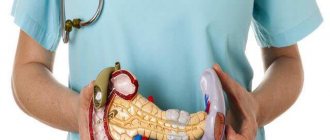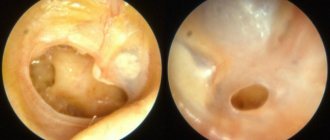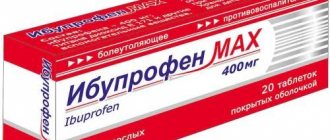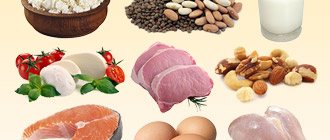Patients should urgently stop any exacerbation of chronic pancreatitis, the symptoms and treatment of which will depend on the general condition of the person and the characteristics of his health. This disease affects the gland that produces pancreatic juice. With proper nutrition, its work is unnoticeable, but exacerbation of chronic pancreatitis cannot pass without a trace. Therapy should be comprehensive and continue until symptoms are completely eliminated. Only a specialist knows how to treat signs of exacerbation of chronic pancreatitis in adults, so if the first symptoms occur, you should contact him immediately.
Causes of exacerbation
The main cause of exacerbation of chronic pancreatitis is alcohol abuse.
Other causes of exacerbation of the disease:
- Mechanical abdominal injuries.
- Complications after surgical operations.
- Diets that involve a minimum of protein.
- Autoimmune diseases.
- Infectious diseases of the body.
- Excessive consumption of fatty and fried foods.
- Hereditary factors.
- High stress on the nervous system, frequent stress.
- Senile age (lack of enzymes in the body).
- Taking toxic medications.
- Smoking, especially if you are overweight.
- Chronic diseases of the liver, duodenum and gall bladder.
During an exacerbation, the activity of pancreatic enzymes sharply increases, the pancreatic tissue is irritated under their influence, swelling occurs, compression of the large pancreatic duct occurs, the blood supply to the gland worsens - the clinical picture resembles acute pancreatitis and, in fact, is not much different from it.
Classification
There is no general classification for chronic pancreatitis, but in medicine a convenient division of pathology is used, which was created in 1980. It is divided into pathology according to clinical manifestation and origin. In the first case, there are:
- A recurrent form, in which periods with sharp pain change to remission.
- Painful appearance, which is accompanied by constant pain.
- Pseudotumoral is chronic pancreatitis, which has obstructive jaundice.
- Latent form, which does not manifest itself with characteristic symptoms.
- The sclerosing type, as a rule, does not develop on its own, but is considered the cause of other types of chronic pancreatitis. Accompanied by obvious pancreatic insufficiency.
Based on its origin, the disease is classified into primary, which occurs due to alcohol abuse, poor diet or toxic poisoning, and secondary or biliary form, which develops against the background of other diseases.
Symptoms of exacerbation of chronic pancreatitis
As a rule, symptoms of exacerbation of chronic pancreatitis develop quite quickly. Already on the first day, a person’s condition deteriorates sharply, as a result of which he has to take medications or seek help from a doctor.
A patient may suspect exacerbations of chronic pancreatitis based on the following clinical signs:
- frequent and loose stools, fat in the stool;
- abdominal pain with vague localization, radiating to the back, worsening after eating;
- bitterness in the mouth, vomiting of bile, which does not bring relief and is difficult to control with medications.
All these clinical signs are not characteristic only of chronic pancreatitis. But if a person has had an exacerbation of this disease not for the first time, he already knows that it was the inflammation of the pancreas that caused the appearance of all the symptoms.
What should be done if abdominal pain and dyspeptic symptoms occur? It is advisable to consult a doctor. If the pain is severe and vomiting cannot be eliminated, you should call an ambulance and immediately take the patient to the intensive care unit to correct water and electrolyte metabolism. Such conditions are life-threatening, so you should not delay seeing a doctor. Exacerbation of pancreatitis may well lead to partial destruction of the pancreas, which may require surgical treatment.
Classification
There is no general classification for chronic pancreatitis, but in medicine a convenient division of pathology is used, which was created in 1980.
It is divided into pathology according to clinical manifestation and origin. In the first case, there are:
- A recurrent form, in which periods with sharp pain change to remission.
- Painful appearance, which is accompanied by constant pain.
- Pseudotumoral is chronic pancreatitis, which has obstructive jaundice.
- Latent form, which does not manifest itself with characteristic symptoms.
- The sclerosing type, as a rule, does not develop on its own, but is considered the cause of other types of chronic pancreatitis. Accompanied by obvious pancreatic insufficiency.
Based on its origin, the disease is classified into primary, which occurs due to alcohol abuse, poor diet or toxic poisoning, and secondary or biliary form, which develops against the background of other diseases.
How long does the attack last?
Chronic pancreatitis in the acute phase can be accompanied by severe pain and a significant deterioration in health. However, not all patients experience such severe pain, but instead they suffer from other symptoms: lack of appetite, high fever, vomiting, diarrhea, etc.
But how long does the acute phase last? Doctors do not give a definite answer, since the duration of the attack is influenced by many factors, for example, the reasons that led to the development of this pathology or the presence of concomitant ailments. On average, during an exacerbation of pancreatitis, an attack lasts 1-2 hours or more than a day.
Diagnosis
To select the correct treatment and determine the severity of the chronic form of pancreatitis in the acute phase, you will need to make a high-quality diagnosis.
Doctors collect tests, and blood results may indicate nonspecific inflammation. Tests are also carried out for the activity of pancreatic enzymes.
Additionally, a coprogram is done to identify fats in the stool, which will be in excess, due to this, enzyme deficiency can be determined.
Other research options include:
- Duodenoradiography.
- Ultrasound of the abdominal cavity and pancreas.
- CT and MRI.
In addition, doctors may use radiography. Based on the results of the examination, treatment is prescribed.
What to do in case of exacerbation?
First of all, you need to call an ambulance. If symptoms of pancreatitis appear, first aid for an exacerbation includes the following steps:
- complete exclusion of food and liquid intake;
- maintaining rest, you need to lie in bed on your back; if you are vomiting, you can take a position lying on your side with your knees pressed to your stomach;
- using an ice pack as a cold compress on the abdominal area.
After delivery to the hospital, the patient will be examined, and based on the results obtained, the doctor will choose the most effective therapeutic tactics. It is prohibited to self-prescribe pills and administer medications during exacerbation of pancreatitis.
If the exacerbation of a chronic process is limited to nausea after eating, the appearance of diarrhea, and abdominal discomfort, you still need to consult a specialist to avoid complications. After the examination, the doctor will decide where it is necessary to undergo treatment - inpatient or outpatient.
Diagnostics
After determining the symptoms and etiology of the disease, the specialist doctor prescribes tests. Usually this:
- general and biochemical blood tests;
- Analysis of urine;
- fecal biochemistry;
- saliva tests to determine amylase levels.
An accurate diagnosis may require additional abdominal tests, such as a CT scan, MRI, x-ray, ultrasound, or endoscopy.
Diagnosis
To select the correct treatment and determine the severity of the chronic form of pancreatitis in the acute phase, you will need to make a high-quality diagnosis.
Doctors collect tests, and blood results may indicate nonspecific inflammation. Tests are also carried out for the activity of pancreatic enzymes.
Additionally, a coprogram is done to identify fats in the stool, which will be in excess, due to this, enzyme deficiency can be determined. Other research options include:
- Duodenoradiography.
- Ultrasound of the abdominal cavity and pancreas.
- CT and MRI.
In addition, doctors may use radiography. Based on the results of the examination, treatment is prescribed.
Drug treatment
Treatment of pancreatitis during an exacerbation should begin immediately and always under the supervision of a specialist. Only a gastroenterologist can prescribe the correct treatment aimed at quickly relieving the exacerbation of the disease and preventing possible complications.
First of all, drug treatment is used:
- Vitamin therapy: fat-soluble A, E, K, D and B vitamins.
- Pancreatic enzymes: Pancreatin, Creon, Panzinorm with lipase at least 10 thousand.
- Drugs aimed at reducing the secretory function of the gland: Esomeprazole, Octreotide, Pantoprazole, Omeprazole.
- Drugs that relieve concomitant pain syndrome. These are antispasmodics: Drotaverine, Mebeverine, Spazmalgon, No-shpa. And also non-steroidal anti-inflammatory drugs: Tramadol, Ketoprofen.
It is worth noting that drug treatment of patients is individual. Only a doctor should select medications after carefully studying the symptoms of the disease. You cannot give injections or take pills without consulting a specialist. This can lead to serious consequences.
Nutrition and diet
In the first few days, fasting is necessary; you can only drink water - purified without gas, or boiled. In the future, the diet is gradually expanded, table No. 1a is prescribed, as in case of exacerbation of gastric ulcer. Protein-rich foods are allowed - lean meat - beef, rabbit, turkey, in the form of steamed meatballs or soufflé, boiled lean fish, steamed protein omelet, low-fat cottage cheese, pureed viscous porridge. Drinks you can drink include tea, rosehip infusion, and blackcurrant compote.
All dishes are prepared either steamed or boiled, carefully chopped or pureed. Portions are small, not exceeding the amount that fits in one handful. The number of meals is from 6 to 8 times a day.
Extractive substances that enhance secretion - strong broths, mushrooms, coffee, cocoa, chocolate, marinades, smoked meats - are excluded from the menu. All foods that require effort from the pancreas - fatty, fried, salty, spicy, seasonings and spices, canned food, cream, sour cream, fatty cottage cheese, lard - will have to be put aside. You can't eat fast food, soda, colorful candies and chocolate bars, chips, crackers, nuts - everything we're used to snacking on on the go. An unconditional, categorical, non-discussable taboo on alcohol. And for beer. And for non-alcoholic drinks, too.
Typically, diet solves about 70% of the problems that arise during exacerbation of chronic pancreatitis. Once you give the gland rest, the inflammation will begin to subside. The main thing is to take the necessary time, and not “break down” when everything starts to get better and stops hurting.
Prevention
Of course, the best treatment is prevention. Chronic pancreatitis can worsen and throw out “surprises” that the patient is not even aware of. This may be hyperglycemia and hypoglycemia, severe vitamin deficiency, processes leading to atrophic gastritis, liver dysfunction and nervous and physical exhaustion.
The basic rule of prevention is very simple. If you want to be healthy, “pass through your head” what gets into your mouth. Before you swallow anything, you need to think about whether it will harm your digestion.
Alcohol should be strictly avoided. In conditions of insulin deficiency, it can lead to hypoglycemia and the development of a serious condition, and if you are “lucky” and a pleasant intoxication develops, then the person “without brakes” gorges on junk food. Therefore, complete abstinence from drinking, smoking (swallowing tobacco saliva irritates the digestive tract) and food temptations will allow you to avoid this disease.
Forms of remission
If you follow all the instructions determined by your attending physician, you can achieve stable remission. And its duration can reach several decades.
There are several forms of this stage of chronic pancreatitis.
- Partial remission
The disease occurs with minimal severity of clinical manifestations. Treatment is carried out in case of presence of symptoms in the acute stage to reduce intensity or completely eliminate.
- Complete remission
In this case, manifestations of the disease are completely absent. Complete remission is divided into stable, in which symptoms do not occur for 6-24 months, and unstable, when the pathology occurs with alternating stages of exacerbation and stages of absence of clinical signs.
Despite the fact that the disease has entered remission, this does not mean that the inflammatory process has disappeared. In any case, it is necessary to maintain the correct image, correct nutrition, and eliminate bad habits.











